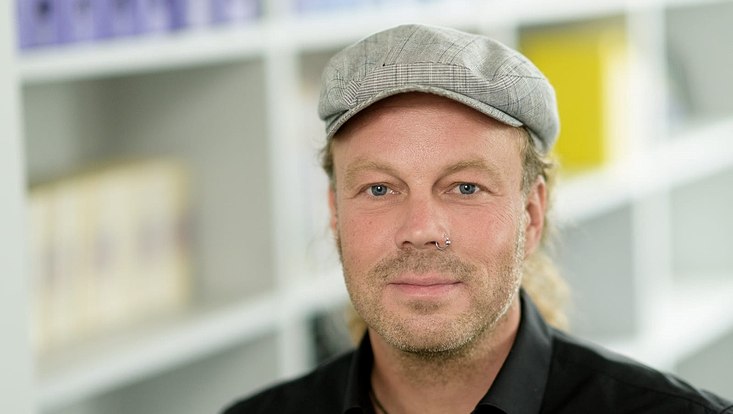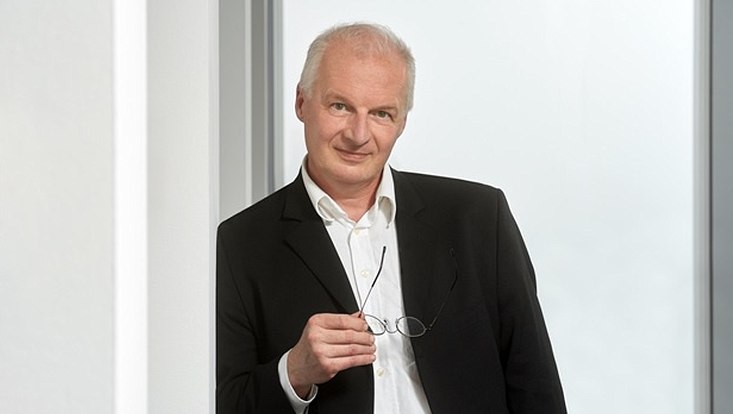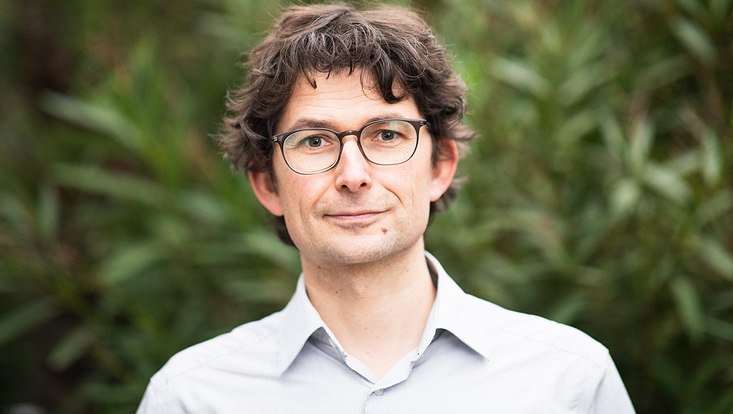Welcome aboard!“From the Gruffalo to Taylor Swift’s songs: literature is not tied to the medium of the book”Prof. Dr. Tobias strengthens the humanities.
8 March 2024, by Kurwinkel/Red.

Photo: Frank Preuß
Every year, Universität Hamburg welcomes numerous new researchers. This series introduces them and their areas of research. This time: literary scholar Prof. Dr. Tobias Kurwinkel.
Prof. Dr. Tobias Kurwinkel is switching from the University of Duisburg-Essen to Universität Hamburg in Winter Semester 2023/24 to take up the Professorship for Modern German Literature with a Focus on Literature and Children's and Youth Cultures.
My research area in 3 sentences:
I am a scholar of literature and, as Albrecht Schöne has written, I look at the human memory of words and sentences—works of writing and poetry.” The recipients of the words and sentences are, in my case, mostly children and young people, the “works of writing and poetry” are picture books and youth novels, but also children’s films and pop songs, meaning from the Gruffalo and Bibi und Tina to The Hunger Games and Taylor Swift’s songs. As Jürgen Fohrmann and Harro Müller once essentially said: Literature is not tied to the medium of the book; literature is one type of one or several kinds of media.
This is how I explain my research to my family:
Storytelling is anthropologically speaking a universal or, more pointedly: human beings are human beings because they tell stories. We tell stories when we meet each other for coffee in the morning, when we talk about our day and want to understand when we exchange information. We tell stories when we entertain—and want to be entertained. The results are cross-medial phenomena and I am working on understanding the “what” and “how” behind them and making them understandable.
For my children and with my children it becomes clear when we listen to The Three Investigators in the car and talk about why the episode is so exciting; when I discuss the film adaptation of One of Us is Lying with my oldest daughter and the borrowings from The Breakfast Club, or when my children explain that it is really “cringe” that I just said “weird.”
In Hamburg, the city and the University, I am looking forward to:
To me, Hamburg is a cosmopolitan, constantly changing city that has a very special northern German flair. I am looking forward to that, and to the museums, the concerts, Sternschanze, and the Karolinenviertel.
The University breathes and lives this openness, this change, and this flair, not least, perhaps, because it is not on the city’s margins but in its center. I want to use the connection between the city and the University and take my teaching and research projects, for example, Illustrators in Residence, from the lecture hall to the street: picture-book illustrators introduce, situate, and reflect upon the aesthetics of their work and the poetry of their images with guests in their studios. There will also be related conversations between artists, moderators, and participants.
The artists of graphic literature often exist at the margins of public and scholarly perception. The teaching and research project, which also includes a book series, is currently putting them and their work into the spotlight.
These are my plans at Universität Hamburg (for example, with regard to knowledge exchange):
Generally, I would like to contribute to the University’s knowledge-exchange activities in the areas of cultural education and scholarly dialogue with projects and concepts such as Illustrators in Residence.
But various publication projects are also important to me that are based in basic research: these include, for example, a series of volumes to introduce scholarship on children’s and youth literature by taking a transmedial narratology approach. I am working on the series of a total of 4 volumes to be published by Narr Francke Ateempto Verlag as textbooks, also with 2 colleagues from the Institute for German Language and Literature.
Another large-scale project is a dictionary of motifs in children’s and youth media and to which numerous colleagues here and abroad are contributing. The dictionary will be published by Metzler Verlag as a so-called “living handbook,” as well as in the form of a bound book. The dictionary is based on a precise, usable concept of “motif,” categorization by motif type in media for children and young people, and a viable analytical tool in the form of a model that will make it possible to identify motifs by their narrative core and in their different, concrete manifestations.
This is why students should come to my lectures:
My courses are characterized by the lively dialogue between students and me as their teacher in a equal partnership. This kind of relationship is the basis for research-based studying, which I try to do to justice to as a higher education principle.
I manage this especially well in seminars and practical courses in which I can integrate the scholarly Internetportal KinderundJugendmedien.de, which I oversee. The portal, which contains scholarly as well as teaching information on topics, developments, and new publications in the special media spectrum for children and adolescents, has become the largest of its kind in the German-speaking world.
For example, I am offering a course soon on current children’s and youth literature in which students will work and research collaboratively in small groups and, at the end, publish their findings on the portal. The seminar involves literary analysis but the students will not only deepen their knowledge of methods and procedures that they can use for children’s and youth literature, but also gain insight through open access into the scholarly publication discourse and they will hone their writing skills.


